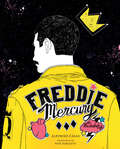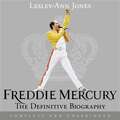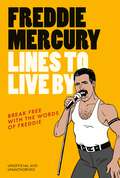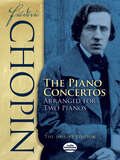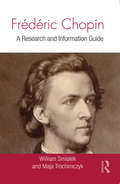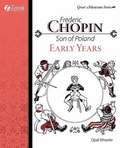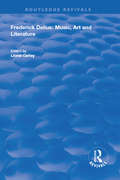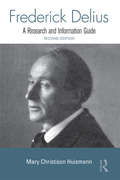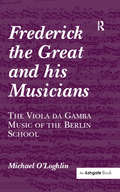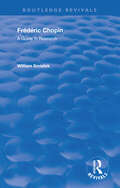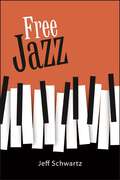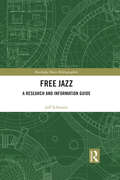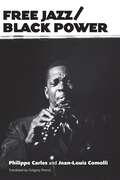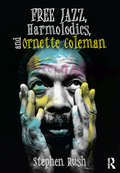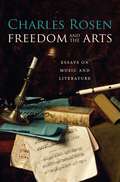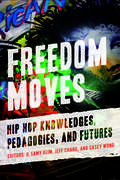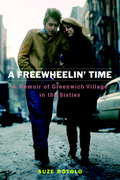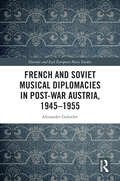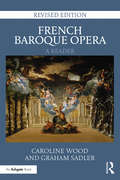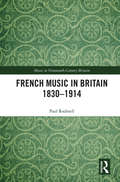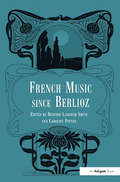- Table View
- List View
Freddie Mercury: An Illustrated Life
by Alfonso CasasThe music of Queen and powerhouse lead singer Freddie Mercury are best experienced with the volume turned all the way up. Alfonso Casas’s Freddie Mercury delivers a sonorous homage to the formidable singer and the turning points that produced a game-changing body of music that continues to inspire fans around the globe. First published in Spain and now available worldwide, this luminous work covers Freddie's three “births”: his birth as Farrokh Bulsara in Zanzibar; his adoption of the last name of Mercury and the launch of Queen with Brian May and Roger Taylor; and the emergence of the lasting legend after Freddie’s death at the age of forty-five. Casas's evocative illustrations highlight the key moments in the singer’s transformation from child prodigy to superstar, bringing to life the bold innovator who broke free of his conventional upbringing. Chronicling events from Freddie’s marriage to Mary Austin and early fame in London’s 1970s glam scene, to the making of multiple megahits (including the six-minute chart-topper “Bohemian Rhapsody”), to his final years in a lasting relationship with Jim Hutton, Freddie Mercury is an exhilarating, poignant portrait of a creative genius who lived life to the hilt.
Freddie Mercury: An Illustrated Life
by Alfonso CasasA beautifully illustrated biography of the iconic lead singer of the British rock band, Queen.The music of Queen and powerhouse lead singer Freddie Mercury are best experienced with the volume turned all the way up. Alfonso Casas&’s Freddie Mercury delivers a sonorous homage to the formidable singer and the turning points that produced a game-changing body of music that continues to inspire fans around the globe.First published in Spain and now available worldwide, this luminous work covers Freddie&’s three &“births:&” his birth as Farrokh Bulsara in Zanzibar; his adoption of the last name of Mercury and the launch of Queen with Brian May and Roger Taylor; and the emergence of the lasting legend after Freddie&’s death at the age of forty-five. Casas&’s evocative illustrations highlight the key moments in the singer&’s transformation from child prodigy to superstar, bringing to life the bold innovator who broke free of his conventional upbringing. Chronicling events from Freddie&’s marriage to Mary Austin and early fame in London&’s 1970s glam scene, to the making of multiple megahits (including the six-minute chart-topper &“Bohemian Rhapsody&”), to his final years in a lasting relationship with Jim Hutton, Freddie Mercury is an exhilarating, poignant portrait of a creative genius who lived life to the hilt.&“Through Casas&’ evocative and vibrant illustrations, [Freddie Mercury] tells the story of Freddie Mercury&’s three &“births:&” from his childhood, growing up as Farrokh Bulsara in Tanzania, to Queen&’s launch to his death at 45.&” —Alcalde &“A beautifully illustrated biography of Freddie Mercury . . . Casas lovingly presents a creative take on the life of Freddie Mercury through the use of dozens of vibrant drawings.&” —OutWord Magazine &“[Freddie Mercury] is an appealingly modest book: Casas aims to let Mercury shine, but his striking illustrations shine in their own right as well.&” —The Current
Freddie Mercury: The Biography
by Laura JacksonThis fascinating biography of Freddie Mercury which received outstanding acclaim from Queen and rock fans worldwide, has now been updated for reissue to coincide with the release of the film about his life. Laura Jackson addresses topics including:* The reality behind Queen's flamboyant front man and lead singer* Mercury the star of mystery - amusing, loyal and generous, yet revealing a dark side to his personality* His frequent use of cocaine and how it heightened his tendency to excess - both on and off stage* The women in his life - his bizarrely enduring relationships with his first love, Mary Austin, and his long-time confidante, Barbara Valentin, who speaks for the first time in this bookThe book also includes new and intimate stories by those who knew him well, such as Tim Rice, Richard Branson, Cliff Richard, Bruce Dickinson, Mike Moran, Wayne Eagling, Zandra Rhodes and Susannah York.
Freddie Mercury: The biography
by Laura Jackson**THE DEFINITIVE, UP-TO-DATE BIOGRAPHY OF FREDDIE MERCURY**'An outstanding biography. . .a fitting testament to the creative genius' -- Daily Mail'Touches all manner of intriguing rock 'n' roll debauchery. . .fascinating reading' -- Time OutThis fascinating biography of Freddie Mercury has received outstanding acclaim from Queen and rock fans worldwide -- now revised and updated to coincide with the release of the film about his life, Bohemian Rhapsody.Born Farrokh Bulsara on the island of Zanzibar, Freddie Mercury rose to worldwide stardom as the lead singer of Britain's biggest music act of all time. In this bestselling biography, Laura Jackson reveals the reality behind Queen's flamboyant frontman and lead singer, as she looks behind his unique brand of showmanship to discover who Freddie Mercury really was. Featuring exclusive interviews with some of those closest to Freddie right up until his tragic death, original Queen members and many others -- including new and intimate stories from Tim Rice, Richard Branson, Cliff Richard, Bruce Dickinson, Mike Moran, Wayne Eagling, Zandra Rhodes and Susannah York -- this is the definitive biography of one of rock's greatest legends.
Freddie Mercury: The Definitive Biography of Freddie Mercury
by Lesley-Ann JonesThis is the definitive biography of Freddie Mercury. Written by an award-winning rock journalist, Lesley-Ann Jones toured widely with Queen forming lasting friendships with the band. Now, having secured access to the remaining band members and those who were closest to Freddie, from childhood to death, Lesley-Ann has written the most in depth account of one of music's best loved and most complex figures. Meticulously researched, sympathetic, unsensational, the book - like the forthcoming film - will focus on the period in the 1980s when Queen began to fragment, before their Live Aid performance put them back in the frame.In her journey to understand the man behind the legend, Lesley-Ann Jones has travelled from London to Zanzibar to India. Packed with exclusive interviews and told with the invaluable perspective that the twenty years since Mercury's death presents, Freddie Mercury is the most up to date portrait of a legendary man.Fully revised and updated edition.(P)2012 Hodder & Stoughton
Freddie Mercury Lines to Live By: Break free with the fabulous insights of a music icon
by Pop Press‘I always knew I was a star. And now, the rest of the world seems to agree with me.’Freddie Mercury was one of biggest icons of the 20th century and his voice, fashion-sense and confidence have been an inspiration to generations.As the lead singer of Queen, Freddie gave the world unforgettable tunes and outrageously stylish music videos. He has inspired generations to know that you should always be proud of who you are.Featuring all of his most-precious wisdom on friendship, creativity, self-belief and love, this collection of quotes will help you feel empowered every time that you feel ‘under pressure’.
Frédéric Chopin: The Joseffy Edition (Dover Classical Piano Music: Four Hands)
by Frédéric ChopinThis volume offers pianists a unique opportunity to study and master Chopin's two piano concertos: The Piano Concerto No. 1 in E Minor, Op. 11, and the Piano Concerto No. 2 in F Minor, Op. 21. Although the composer wrote both works to launch his career as a concert artist, he soon abandoned the concert hall for the more intimate atmosphere of the salon and turned his creative attentions to the brilliant shorter works on which his reputation rests today. The concerti remain among the composer's few ventures in longer and more comprehensive musical forms.Extended stretches of brilliant passagework and many moments of exquisite loveliness have made both works favorites with music lovers. Now pianists can explore their beauty and expressiveness with this practical playing and study edition. It contains the original solo piano parts of the concerti as well as a skillful piano reduction of the original orchestral parts. This means a pianist can play the solo part while the second piano functions as the "orchestra." Clearly printed and sturdily bound in this high-quality volume, these scores are an effective, practical way for students to learn, practice, and rehearse these masterworks of the piano repertoire.
Frédéric Chopin: A Research and Information Guide (Routledge Music Bibliographies)
by William Smialek Maja TrochimczykFrédéric Chopin: A Research and Information Guide is an annotated bibliography concerning both the nature of primary sources related to the composer and the scope and significance of the secondary sources which deal with him, his compositions, and his influence as a composer. The second edition includes research published since the publication of the first edition and provides electronic resources.
Frederic Chopin, Son of Poland, Early Years
by Opal WheelerFrederic Chopin was a celebrated pianist and probably the greatest composer for the piano the world has ever known. In this book, Frederic Chopin's childhood and boyhood are dramatically presented. Frederic Chopin was born in a little cottage in Poland on the estate of Count Skarbek, whose children were tutored by his father, Nicolas Chopin. The child loved music from babyhood and when the family moved to Warsaw a few years after his birth, he was placed under the tutelage of the best masters of music in Poland. His astounding performance in playing the solo part of a difficult concerto with the full Warsaw orchestra when only nine years of age marked little Frederic as the genius he was. Through the early years to that momentous day in Vienna when his playing at the theater of Count Gallenberg actually launched his career as a major figure in the world of music, Frederic Chopin, Son of Poland, Later Years completes the great man's life story.
Frederick Delius: Music, Art and Literature (Routledge Revivals)
by Lionel CarleyFirst published in 1998, Carley collates twelve essays by an international group of contributors reflects the truly cosmopolitan nature of Delius’s life and his music. They reveal the manner in which he absorbed the culture of the nations he came to know, their music, art and literature, and the influences they brought to bare on his own work. Also discussed are some of the often mixed, but rarely equivocal reactions that performances of his music have reactions over the years, with Lionel Carley’s in-depth study of the first production of Foleraadet in 1897, and a wide ranging analysis by Don Gillespie and Robert Beckhard of the critical reception of Delius’s music in the United States between 1909 and 1920.
Frederick Delius: A Research and Information Guide (Routledge Music Bibliographies)
by Mary Christison HuismannFrederick Delius is among the most celebrated English composers of the 20th century. Widely studied and performed, his works are considered models of the British impressionist school and continue to fascinate students and scholars centuries later. This research guide serves as a ready reference for students and scholars, but will also be interesting to read and useful for anyone who wants to know where to begin to learn more about this important composer.
Frederick the Great and his Musicians: The Viola da Gamba Music of the Berlin School
by Michael O'LoghlinAfter decades of stagnation during the reign of his father, the 'Barracks King', the performing arts began to flourish in Berlin under Frederick the Great. Even before his coronation in 1740, the crown prince commenced recruitment of a group of musician-composers who were to form the basis of a brilliant court ensemble. Several composers, including C.P.E. Bach and the Graun brothers, wrote music for the viola da gamba, an instrument which was already becoming obsolete elsewhere. They were encouraged in this endeavour by the presence in the orchestra from 1741 of Ludwig Christian Hesse, one of the last gamba virtuosi, who was described in 1766 as 'unquestionably the finest gambist in Europe'. This study shows how the unique situation in Berlin produced the last major corpus of music written for the viola da gamba, and how the more virtuosic works were probably the result of close collaboration between Hesse and the Berlin School composers. The reader is also introduced to the more approachable pieces which were written and arranged for amateur viol players, including the king's nephew and ultimate successor, Frederick William II. O'Loghlin argues that the aesthetic circumstances which prevailed in Berlin brought forth a specific style that is reflected not only in the music for viola da gamba. Characteristics of this Berlin style are identified with reference to a broad selection of original written sources, many of which are hardly accessible to English-speaking readers. There is also a discussion of the rather contradictory reception history of the Berlin School and some of its composers. The book concludes with a complete thematic catalogue of the Berlin gamba music, with a listing of original manuscript sources and modern publications. The book will appeal to professional and amateur viola da gamba players as well as to scholars of eighteenth-century German music.
Fredric Chopin: A Research and Information Guide
by William SmialekImportant books, articles, reviews, and theses on Fr d ric Chopin (1810-1849) in Western European languages and in Polish are cited; selected references in languages such as Russian, Czech, and Japanese are included as well. The Chopin legend is considered through studies of the performance tradition and a discography of recent and reissued recordings. Short essays outline the historiography of Chopin research and the current direction of scholarship. Index.
Free Jazz: A Research And Information Guide (SUNY Press Jazz Styles)
by Jeff SchwartzIn the late 1950s, free jazz broke all the rules, liberating musicians both to create completely spontaneous and unplanned performances and to develop unique personal musical systems. This genre emerged alongside the radical changes of the 1960s, particularly the Civil Rights, Black Arts, and Black Power movements. Free Jazz is a new and accessible introduction to this exciting, controversial, and often misunderstood music, drawing on extensive research, close listening, and the author’s experience as a performer. More than a catalog of artists and albums, the book explores the conceptual areas they opened: freedom, spirituality, energy, experimentalism, and self-determination. These are discussed in relation to both the political and artistic currents of the times and to specific musical techniques, explained in language clear to ordinary readers but also useful for musicians.
Free Jazz: A Research and Information Guide (Routledge Music Bibliographies)
by Jeff SchwartzFree Jazz: A Research and Information Guide offers carefully selected and annotated sources on free jazz, with comprehensive coverage of English-language academic books, journal articles, and dissertations, and selective coverage of trade books, popular periodicals, documentary films, scores, Masters’ theses, online texts, and materials in other languages. Free Jazz will be a major reference tool for students, faculty, librarians, artists, scholars, critics, and serious fans navigating this literature.
Free Jazz/Black Power (American Made Music Series)
by Philippe Carles Jean-Louis ComolliIn 1971, French jazz critics Philippe Carles and Jean-Louis Comolli cowrote Free Jazz/Black Power, a treatise on the racial and political implications of jazz and jazz criticism. It remains a testimony to the long-ignored encounter of radical African American music and French left-wing criticism. Carles and Comolli set out to defend a genre vilified by jazz critics on both sides of the Atlantic by exposing the new sound’s ties to African American culture, history, and the political struggle that was raging in the early 1970s. The two offered a political and cultural history of Black presence in the United States to shed more light on the dubious role played by jazz criticism in racial oppression. This analysis of jazz criticism and its production is astutely self-aware. It critiques the critics, building a work of cultural studies in a time and place where the practice was virtually unknown. The authors reached radical conclusions—free jazz was a revolutionary reaction against white domination, was the musical counterpart to the Black Power movement, and was a musical style that demanded a similar political commitment. The impact of this book is difficult to overstate, as it made readers reconsider their response to African American music. In some cases, it changed the way musicians thought about and played jazz. Free Jazz/Black Power remains indispensable to the study of the relation of American free jazz to European audiences, critics, and artists. This monumental critique caught the spirit of its time and realigned that zeitgeist.
Free Jazz, Harmolodics, and Ornette Coleman
by Stephen RushFree Jazz, Harmolodics, and Ornette Coleman discusses Ornette Coleman’s musical philosophy of "Harmolodics," an improvisational system deeply inspired by the Civil Rights Movement. Falling under the guise of "free jazz," Harmolodics can be difficult to understand, even for seasoned musicians and musicologists. Yet this book offers a clear and thorough approach to these complex methods, outlining Coleman’s position as the developer of a logical—and historically significant—system of jazz improvisation. Included here are detailed musical analyses of improvisations, accompanied by full transcriptions. Intimate interviews between the author and Coleman explore the deeper issues at work in Harmolodics, issues of race, class, sex, and poverty. The principle of human equality quickly emerges as a central tenet of Coleman’s life and music. Harmolodics is best understood when viewed in its essential form, both as a theory of improvisation and as an artistic expression of racial and human equality.
Freedom and the Arts: Essays on Music and Literature
by Charles RosenIs there a moment in history when a work receives its ideal interpretation? Or is negotiation always required to preserve the past and accommodate the present? The freedom of interpretation, Charles Rosen suggests in these sparkling explorations of music and literature, exists in a delicate balance with fidelity to the identity of the original work. Rosen cautions us to avoid doctrinaire extremes when approaching art of the past. To understand Shakespeare only as an Elizabethan or Jacobean theatergoer would understand him, or to modernize his plays with no sense of what they bring from his age, deforms the work, making it less ambiguous and inherently less interesting. For a work to remain alive, it must change character over time while preserving a valid witness to its earliest state. When twentieth-century scholars transformed Mozart's bland, idealized nineteenth-century image into that of a modern revolutionary expressionist, they paradoxically restored the reputation he had among his eighteenth-century contemporaries. Mozart became once again a complex innovator, challenging to perform and to understand. Drawing on a variety of critical methods, Rosen maintains that listening or reading with intensity-for pleasure-is the one activity indispensable for full appreciation. It allows us to experience multiple possibilities in literature and music, and to avoid recognizing only the revolutionary elements of artistic production. By reviving the sense that works of art have intrinsic merits that bring pleasure, we justify their continuing existence.
Freedom Moves: Hip Hop Knowledges, Pedagogies, and Futures (California Series in Hip Hop Studies #3)
by H. Samy Alim, Jeff Chang, and Casey Philip WongThis expansive collection sets the stage for the next generation of Hip Hop scholarship as we approach the fiftieth anniversary of the movement’s origins. Celebrating 50 years of Hip Hop cultural history, Freedom Moves travels across generations and beyond borders to understand Hip Hop’s transformative power as one of the most important arts movements of our time. This book gathers critically acclaimed scholars, artists, activists, and youth organizers in a wide-ranging exploration of Hip Hop as a musical movement, a powerful catalyst for activism, and a culture that offers us new ways of thinking and doing freedom. Rooting Hip Hop in Black freedom culture, this state-of-the-art collection presents a globally diverse group of Black, Indigenous, Latinx, Asian American, Arab, European, North African, and South Asian artists, activists, and thinkers. The "knowledges" cultivated by Hip Hop and spoken word communities represent emerging ways of being in the world. Freedom Moves examines how educators, artists, and activists use these knowledges to inform and expand how we understand our communities, our histories, and our futures.
A Freewheelin' Time: A Memoir of Greenwich Village in the Sixties
by Suze RotoloRotolo, who was romantically involved with Bob Dylan from 1961 to 1964 (she's the girl on the cover of his debut album), has written this memoir of the rise of the folk music movement in Greenwich Village from a firsthand perspective. Exhibiting a writing style that is succinct yet impassioned, she vividly recreates that period in history while recounting her own growing political awareness, and explains how folk music eventually led her to a life of activism (she became involved in the Civil Rights Movement). Fans of Bob Dylan and folk music in general should enjoy this volume. Annotation ©2008 Book News, Inc. , Portland, OR (booknews. com)
French and Soviet Musical Diplomacies in Post-War Austria, 1945-1955 (Slavonic and East European Music Studies)
by Alexander GolovlevFrench and Soviet Musical Diplomacies in Post-War Austria, 1945-1955 investigates how promoting 'national' music and musicians was used as an important asset by France and the USSR in post-Nazi Austria, covering music’s role in international relations at various levels, within changing power frameworks. Bridging international relations, musical sociology, media studies, and Cold War history, four incisive chapters examine the crossroads of Soviet, French, and Austrian cultural politics and discourse-building, presented in two parts - institutions of musical diplomacy: Soviet and French cultural diplomats in comparison; sounds of music coming to Austria: Soviet and French musicians on tour. Using a communication- and media-oriented approach, this study casts new light, firstly, on the interpretative power of 'receiving' publics and, secondly, on the role of cultural transmitters at different levels. This is a valuable study for those specialising in Russian and East European music and music and politics. It will also appeal to cultural historians and all those interested in the intersections between music, international relations, and Cold War history.
French Baroque Opera: Revised Edition
by Caroline Wood Graham SadlerFrom the outset, French opera generated an enormous diversity of literature, familiarity with which greatly enhances our understanding of this unique art form. Yet relatively little of that literature is available in English, despite an upsurge of interest in the Lully-Rameau period during the past two decades. This book presents a wide-ranging and informative picture of the organization and evolution of French Baroque opera, its aims and aspirations, its strengths and weaknesses. Drawing on official documents, theoretical writings, letters, diaries, dictionary entries, contemporary reviews and commentaries, it provides an often entertaining insight into Lully’s once-proud Royal Academy of Music and the colourful characters who surrounded it. The translated passages are set in context, and readers are directed to further scholarly and critical writings in English. Readers will find this new, updated edition easier to use with its revised and expanded translations, supplementary explanatory content and new illustrations.
French Music and Jazz in Conversation
by Deborah MawerFrench concert music and jazz often enjoyed a special creative exchange across the period 1900-1965. French modernist composers were particularly receptive to early African-American jazz during the interwar years, and American jazz musicians, especially those concerned with modal jazz in the 1950s and early 1960s, exhibited a distinct affinity with French musical impressionism. But despite a general, if contested, interest in the cultural interplay of classical music and jazz, few writers have probed the specific French music-jazz relationship in depth. In this book, Deborah Mawer sets such musical interplay within its historical-cultural and critical-analytical contexts, offering a detailed yet accessible account of both French and American perspectives. Blending intertextuality with more precise borrowing techniques, Mawer presents case studies on the musical interactions of a wide range of composers and performers, including Debussy, Satie, Milhaud, Ravel, Jack Hylton, George Russell, Bill Evans and Dave Brubeck.
French Music in Britain 1830–1914 (Music in Nineteenth-Century Britain)
by Paul J RodmellFrench Music in Britain 1830–1914 investigates the presence, reception and influence of French art music in Britain between 1830 (roughly the arrival of ‘Grand Opera’ and opéra comique in London) and the outbreak of the First World War. Five chronologically ordered chapters investigate key questions such as: * Where and to whom was French music performed in Britain in the nineteenth century? * How was this music received, especially by journal and newspaper critics and other arbiters of taste? * What characteristics and qualities did British audiences associate with French music? * Was the presence and reception of French music in any way influenced by Franco-British political relations, or other aspects of cultural transfer and exchange? * Were British composers influenced by their French contemporaries to any extent and, if so, in what ways? Placed within the wider social and cultural context of Britain’s most ambiguous and beguiling international relationship, this volume demonstrates how French music became an increasingly significant part of the British musician’s repertory and influenced many composers. This is an important resource for musicologists specialising in Nineteenth-Century Music, Music History, and European Music. It is also relevant for scholars and researchers of French Studies and Cultural Studies.
French Music Since Berlioz
by Caroline PotterFrench Music Since Berlioz explores key developments in French classical music during the nineteenth and twentieth centuries. This volume draws on the expertise of a range of French music scholars who provide their own perspectives on particular aspects of the subject. D dre Donnellon's introduction discusses important issues and debates in French classical music of the period, highlights key figures and institutions, and provides a context for the chapters that follow. The first two of these are concerned with opera in the nineteenth and twentieth centuries respectively, addressed by Thomas Cooper for the nineteenth century and Richard Langham Smith for the twentieth. Timothy Jones's chapter follows, which assesses the French contribution to those most Germanic of genres, nineteenth-century chamber music and symphonies. The quintessentially French tradition of the nineteenth-century salon is the subject of James Ross's chapter, while the more sacred setting of Paris's most musically significant churches and the contribution of their organists is the focus of Nigel Simeone's essay. The transition from the nineteenth to the twentieth century is explored by Roy Howat through a detailed look at four leading figures of this time: Faur Chabrier, Debussy and Ravel. Robert Orledge follows with a later group of composers, Satie & Les Six, and examines the role of the media in promoting French music. The 1930s, and in particular the composers associated with Jeune France, are discussed by Deborah Mawer, while Caroline Potter investigates Parisian musical life during the Second World War. The book closes with two chapters that bring us to the present day. Peter O'Hagan surveys the enormous contribution to French music of Pierre Boulez, and Caroline Potter examines trends since 1945. Aimed at teachers and students of French music history, as well as performers and the inquisitive concert- and opera-goer, French Music Since Berlioz is an essential companion for an
